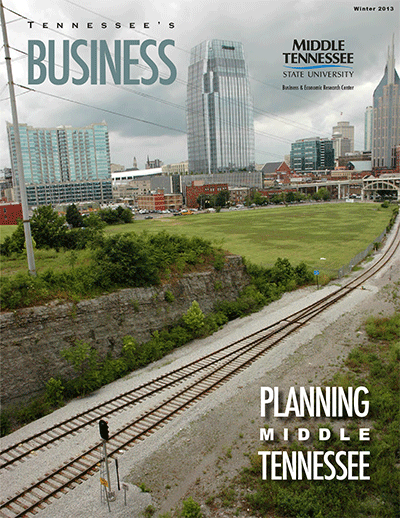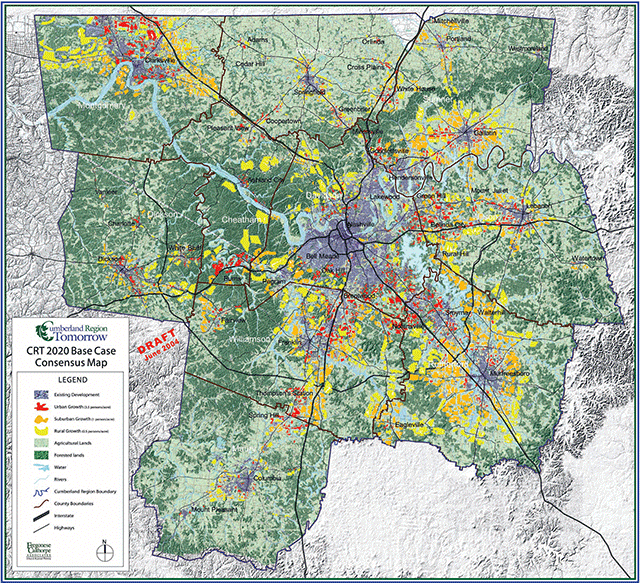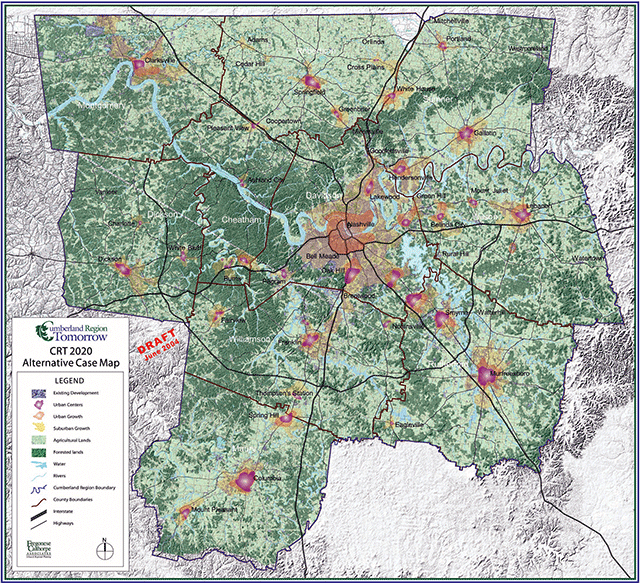| Cumberland Region Tomorrow (CRT) is a regional collaborative partnership bringing public and private sector leaders and organizations across middle Tennessee together to educate, communicate, and collaborate on shared regional issues and opportunities. CRT's work supports and encourages growth planning with emphasis on land use, transportation, and preservation of the rural landscape and character of the 10-county region's communities.
Through extensive research and involvement of the public, local and state elected officials, the business community, and other stakeholders, CRT has gathered information on what residents of the region value and how they think growth should be guided. This research involved hundreds of the region's citizens in workshops guided by top national regional planning consultants John Fregonese and Associates. The Fregonese-led regional visioning process has been used extensively in regions throughout the nation including Austin, Salt Lake City, and the Chattanooga Region's Thrive 2055 Regional Planning effort as well as internationally in Australia and Europe in support of successful regional growth planning and implementation efforts.
Results of the middle Tennessee regional visioning project were published in 2003 in the CRT Report to the Region. The project revealed that residents in the region wanted to conserve and enhance the region's unique communities and landscapes. By successfully doing so, the region is now maintaining and enhancing its unique regional attributes that provide great quality of life and at the same time support middle Tennessee's economic competitiveness and job opportunities, create quality communities, and ensure wise use of our fiscal and land resources.
CRT believes middle Tennessee can preserve its quality of life and accommodate rapid growth in the region that is sure to come. To do so will require agreement among many key groups to determine the best locations for future growth and development. These groups must work together to learn better ways and change where and how development occurs. Updates through new comprehensive plans throughout the region are providing frameworks to guide growth in new ways. New partnerships have been formed, and successful collaboration among groups that have not previously communicated and worked together is occurring. This collaborative action for quality growth is accomplishing remarkable results in local and regional comprehensive planning and implementation that align with regional priorities. |
 |


CRT's work supports and encourages growth planning with emphasis on land use, transportation, and preservation of the rural landscape and character of the 10-county region. |
A New Alternative for Regional Quality Growth
Today the 10-county region is growing at a much faster rate than CRT's Base Case Trends predicted in 2000 when the region's population was 1.4 million. At that time 467,000 new residents were predicted to arrive by the year 2020. Middle Tennessee's current population of nearly 1.8 million residents requires new housing and transportation options and more community services through local and state governments than ever before. Current estimates for the year 2035 predict 1 million new residents for a total population of nearly 3 million expected to call the 10-county region home.
Estimated new infrastructure costs to support these new residents is projected to be $7 billion by 2020 if the region continues to grow and develop similarly to the 1990s. Based on this information and shared objectives for preferred growth and development outcomes, hundreds of leaders have come together to avoid undesirable fiscal effects as well as unreplaceable loss of the region's land, air, water, and our ultimate quality of life that would result if the region does not move from the Base Case to the Alternative Case Scenario illustrated here.
The Base Case scenario was developed by regional citizens during the first series of CRT Regional Visioning Project workshops in the early 2000s. Participants used regional maps and CRT trend data to forecast where growth and development would most likely occur in the next 20 years if nothing was done to change existing growth and development practices. Predictions of the Base Case are apparent in sprawl such as development patterns that currently dominate rapidly growing areas of the region. Fiscal difficulties resulting from the cost of community services necessary to support this pattern of growth have occurred in the faster-growing counties of the region, causing new urgency to use comprehensive planning and quality growth practices as a way to a desired future trend.
In order to change, a future view is essential. The Alternative Case incorporates preferences for regional growth and development as recommended by 83% of citizens participating in the second series of CRT Regional Visioning Project workshops. This preferred scenario is intended to illustrate at a high level the concepts of regional distribution of growth and development that accommodates the same amounts of population, growth, and development as the Base Case scenario and answers the workshop consensus for cities that retain their individual qualities while not growing together, more lifestyle and housing options, more access to open space, and less automobile traffic.
Specifically, the Alternative Case differs from the Base Case scenario in that it
- uses less land to accommodate projected growth development,
- provides a greater variety of housing types,
- locates jobs in existing centers and downtowns, and
- focuses new jobs on transit lines or new industrial sites.
Upon comparison, the Alternative Case is quite different from growth and development patterns in the Base Case. Based on the input of thousands of middle Tennessee citizens and leaders, we know we don't want to be the South's next Atlanta and face the problems that region is now working to resolve.
Quantification of this difference is presented in the CRT Report to the Region. This analysis details striking differences between the fiscal, infrastructure, and natural resource effects of the two scenarios, shown in the table.
Significant savings in infrastructure costs along with return on planned regional transit investments are now being realized as middle Tennessee works to implement the Nashville Area Metropolitan Planning Organization 2035 Regional Transportation Plan in concert with aligned local comprehensive plans containing quality growth principles and practices in keeping with the Alternative Case recommendations.
CRT received regional endorsement at the 2003 Regional Planning Summit to continue its work in support of desired quality growth and development outcomes. CRT's work from 2004 until now to create and implement the CRT Quality Growth Toolbox Project is supporting local and regional leaders in accomplishing this change. Integrated local and regional land-use transportation plans and investments are now a reality in middle Tennessee that supports the region's shared goals of economic competitiveness, job creation, quality community development, and wise use of fiscal resources.
CRT's Role
The primary role for leadership in implementing quality growth falls on local governments, state and local incentives, and the actions of developers and consumers in the region. CRT's objectives are to continue regional discussion of quality growth, report on growth-trend data, lead the process to develop tools and resources necessary to implement quality growth practices, encourage collaborative action, and recognize and reward successful examples of quality growth projects in the region.
CRT is supporting progress in middle Tennessee over time by working with the entities that hold responsibility for these goals and strategies and will continue to encourage regional collaborative efforts as needed in support of sound growth planning and implementation. Most of the strategies are incremental steps taking place over time in sync with the right regulatory and market environment. CRT's role is to encourage the creation of that environment for regional quality growth.
Think Regionally, Act Locally
CRT's efforts acknowledge that every community is unique, with distinctive characteristics and needs, which is what makes middle Tennessee so special and desirable. In some communities, land and open space preservation strategies may be needed while in others growth planning, downtown revitalization, or improved development practices may be more appropriate. CRT encourages the implementation of these efforts incrementally as appropriate in the communities of the 10-county Cumberland region while balancing local priorities with regional problem-solving and growth-planning needs.
While recognizing this need to respect community individuality and local control, complex issues exist that cannot effectively be addressed at the local level but rather require a regional or subregional solution. Major infrastructure investments such as transportation and power systems and air-quality compliance are examples of such issues. From Springfield to Columbia and from Murfreesboro to Clarksville, the region shares common problems and opportunities. In these cases, CRT will continue to encourage regional collaborative action and work to build consensus among groups and communities toward mutually beneficial solutions.
Creating More Choices for the Future
The regional quality growth goals and strategies are not aimed toward restrictions or additional layers of government but to help communities and decision makers guide growth and development while creating a broader array of choices. This sentiment for more choice was resoundingly endorsed in all of the public workshops CRT conducted. CRT believes the region can create more choices for the future. CRT promotes working together in order to offer a wider array of development types, transportation options, and housing choices and to create more incentives and tools for landowners who desire to continue their ownership in the face of development pressures.
Providing more choices will help the region address air and water quality and quantity issues and the rapid rate of land consumption. Growth will increase the demand for land. While the region's land mass is adequate to meet this demand, it will cost billions of dollars to construct the infrastructure required by sprawling development patterns if we do nothing to change. Now that the regional call for quality growth and development is clearer, CRT continues to lead the region's discussion, continued learning, and implementation toward this end.
For more information, see CRT Retional Visioning and Scenario Planning.
* Bridget Jones is executive director of Cumberland Region Tomorrow. |
|
Significant savings in infrastructure costs and return on planned regional transit investments are now being realized through implementation of the MPO's 2035 Regional Transportation Plan in concert with aligned local comprehensive plans.
Based on the input of thousands of middle Tennessee citizens and leaders, we know we don't want to be the South's next Atlanta and face the problems that region is now working to resolve.
CRT's analysis quantifies and details striking differences between the fiscal, infrastructure, and natural resource effects of the two scenarios,
shown in the table. |



